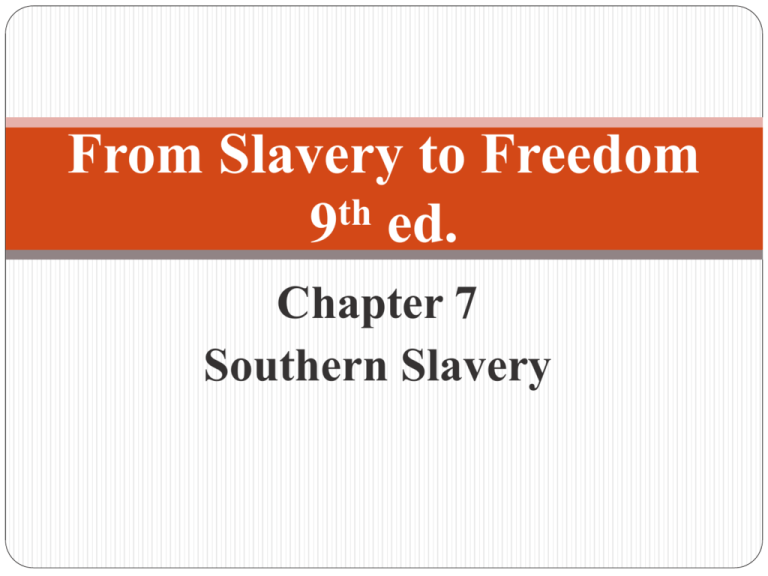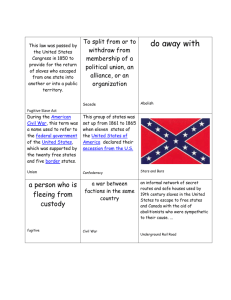
From Slavery to Freedom
th
9 ed.
Chapter 7
Southern Slavery
The Domestic Slave Trade
King Cotton
Technology supported expansion of slave labor
Eli Whitney’s 1794 invention of the cotton gin
Louisiana, Mississippi, and Alabama rapidly
grew with demand for cotton and sugarcane
Growing prosperity in new states caused wave
of migrants and greater demand for slaves
Insatiable demand for cotton resulted in:
acquisition of Florida; admission of Missouri as
slave state; annexation of Texas; war with Mexico
2
© 2010 The McGraw-Hill Companies, Inc. All Rights Reserved.
The Cotton Gin
3
© 2010 The McGraw-Hill Companies, Inc. All Rights Reserved.
The domestic slave trade 1808-1865
4
© 2010 The McGraw-Hill Companies, Inc. All Rights Reserved.
The Domestic Slave Trade
The Interstate Slave Trade
Domestic slave trade augmented westward
movement
After 1808 illegalization of Atlantic slave trade,
interstate trade became increasingly profitable
Slaves brought overland; mostly chained and
on foot
Slaves a “product” sold by business firms,
lottery, and by slave-trading firms
5
© 2010 The McGraw-Hill Companies, Inc. All Rights Reserved.
1835 advertisement for slaves
6
© 2010 The McGraw-Hill Companies, Inc. All Rights Reserved.
The Domestic Slave Trade
Speculation integral to slave-trading business
Slaves gathered in pens for direct shipment to
New Orleans or for resale to other long-distance
traders
Until ended by Congressional action in 1850,
District of Columbia seat of slave trade
7
© 2010 The McGraw-Hill Companies, Inc. All Rights Reserved.
Alexandria slave pen
8
© 2010 The McGraw-Hill Companies, Inc. All Rights Reserved.
The Domestic Slave Trade
A Capitalist Enterprise
Slave trade financially driven; mostly seen as a
capitalistic enterprise
Families separated because slaves brought higher
prices when sold individually
Separation of Families by Sale
Harriet Tubman
Large number of single slaves on market
evidence of constant separation of families
9
© 2010 The McGraw-Hill Companies, Inc. All Rights Reserved.
The Domestic Slave Trade
Market Prices
Prices of slaves responded to market factors
As demand increased, so did the price of slaves
After financial turmoil, price and demand slumped
10
© 2010 The McGraw-Hill Companies, Inc. All Rights Reserved.
Insert Table: Average Prices of
Prime Field Hands (young slave
men, able-bodied but unskilled)
Average Prices of Prime Field Hands (young slave
men, able-bodied but unskilled)
11
© 2010 The McGraw-Hill Companies, Inc. All Rights Reserved.
Persistence of the African Trade
Extent of the Illegal Trade
Atlantic slave trade continued despite its
illegality
The Movement to Reopen the African Trade
Between 1854 and 1860, every southern
commercial convention considered proposals to
reopen Atlantic slave trade
1808 federal law so weak and lax, repeal not
really necessary
12
© 2010 The McGraw-Hill Companies, Inc. All Rights Reserved.
Insert Map: The illegal slave
trade to the United States, 18081860
The illegal slave trade to the
United States, 1808-1860
13
© 2010 The McGraw-Hill Companies, Inc. All Rights Reserved.
The Slave Codes
The Slave Codes
Passage of slave codes accompanied expansion
of slavery
Codified viewpoint that slaves were not people but
property
Slaves denied most rights and freedoms
Laws often made stricter in response to insurrections
Enforcement
Machinery set up for enforcement of slave codes
Reluctant to imprison because it meant taking
away an owner’s investment
14
© 2010 The McGraw-Hill Companies, Inc. All Rights Reserved.
The Slave Codes
The Patrol System
A type of militia; free white men expected to
serve on patrol for period of time apprehending
runaway slaves and returning them to masters
In quiet times, slave codes disregarded, and
slaves given more freedoms
Masters tended to prefer taking matters regarding
their slaves into their own hands
15
© 2010 The McGraw-Hill Companies, Inc. All Rights Reserved.
On the Plantation
On the Plantation
Work of slaves primarily agricultural
In 1860, ¾ of white people in South did not own
slaves
Slaves concentrated in hands of relatively few
Bulk of staple crops produced on large plantations
Owners dominated political and economic thinking
Field Hands
Large plantations had two groups of workers:
house servants and field hands
16
© 2010 The McGraw-Hill Companies, Inc. All Rights Reserved.
On the Plantation
Work regimen for cotton demanding
Gang-labor system used
Believed that one slave needed for every 3 acres
of cotton
Work hours longest during harvest time
Gender Division of Labor
Certain jobs indentified by sex
Slave women integral to plantation economy
Ranked each other’s status according to creative ability
Also worked in fields alongside men
17
© 2010 The McGraw-Hill Companies, Inc. All Rights Reserved.
Cotton and slaves,
1820 and 1860
18
© 2010 The McGraw-Hill Companies, Inc. All Rights Reserved.
On the Plantation
Overseers and Brutality
Overseers employed on farms of more than 20
slaves where owner was an absentee landlord
No personal interest in slaves’ welfare
Owners demanded overseers get most out of
slaves; often treated slaves with brutality
Some plantations employed driver slaves who
assisted overseer and compelled work from
fellow slaves
Often viewed as a traitor by other slaves
19
© 2010 The McGraw-Hill Companies, Inc. All Rights Reserved.
On the Plantation
The Slave Diet
Each slave household received ration of meal
and salt pork
Sometimes allowed to maintain own gardens
Some even allowed to market their produce
20
© 2010 The McGraw-Hill Companies, Inc. All Rights Reserved.
Urban and Nonagricultural
Slavery
Black Artisans and Inventors
Slaves demonstrated diversity of talent in skilled
trades
Slaves used in pottery and textile mills, iron
furnaces, and tobacco factories
Slaves proved value as inventors
Not allowed to get patent; after 1861 slave owner
could be issued patent for his or her slave’s invention
21
© 2010 The McGraw-Hill Companies, Inc. All Rights Reserved.
Haywood Dixon, slave carpenter
22
© 2010 The McGraw-Hill Companies, Inc. All Rights Reserved.
Urban and Nonagricultural
Slavery
Slave Hiring
Owners put slaves out for hire in period between
harvest and new planting
Some urban slaves allowed to self-hire; although
illegal under southern law
Self-hire gave dual sense of freedom and its limits
Slaves could not legally contract for their
services; contract was between master and hiring
employer
23
© 2010 The McGraw-Hill Companies, Inc. All Rights Reserved.
Social and Cultural Life
Social and Cultural Life
Slaves’ personal expression and recreation a
rejection of chattel principle
Religious Activity
Worship services held on larger plantations and
in towns
With rise of abolition movement and rumors of
slave conspiracies, slaves increasingly made to
attend owners’ churches
Sat in separate sections; earliest example of segregation
24
© 2010 The McGraw-Hill Companies, Inc. All Rights Reserved.
Slave wedding in Virginia 1838
25
© 2010 The McGraw-Hill Companies, Inc. All Rights Reserved.
Social and Cultural Life
The Slave Church
Blended Christianity and folk beliefs
Slave Families
Permanency of slave marriage depended on
opportunity to live and work together
Childbearing difficult; inadequate medical care
Interracial Relationships
Children born of slave women and white men
visible throughout South
Most often the result of physical coercion
26
© 2010 The McGraw-Hill Companies, Inc. All Rights Reserved.
Social and Cultural Life
Mulatto Slaves
Treatment by white fathers varied
Some emancipated their slave children
27
© 2010 The McGraw-Hill Companies, Inc. All Rights Reserved.
Resistance
Slave Market Gambits
Slaves used tricks in order to gain control over
would-be purchasers
Exhibited behavior appealing to a master of their
choosing; pretended to be sick or weak in front of
undesirable master
Sabotage and Suicide
Engaged in sabotage like breaking farm tools
Suicide widespread
Also performed acts of self-mutilation to render
themselves ineffective workers
28
© 2010 The McGraw-Hill Companies, Inc. All Rights Reserved.
Resistance
Running Away
Most common form of overt resistance was
running away
Federal and state legislation sought to aid in
recovery of runaway slaves
Violent Resistance
Owners feared violent resistance
Use of poison against masters; Murder of masters
Slave Revolts
Slaves emboldened by Haitian revolution
29
© 2010 The McGraw-Hill Companies, Inc. All Rights Reserved.
Reward handbill for a
runaway slave, 1837
30
© 2010 The McGraw-Hill Companies, Inc. All Rights Reserved.
Major American Slave Rebellions
31
© 2010 The McGraw-Hill Companies, Inc. All Rights Reserved.
Resistance
Denmark Vesey
Freed black who plotted slave revolt
Whites caught wind of conspiracy and rounded
up suspects
Nat Turner
Believed he had been selected by divine power to
deliver his people from slavery
Began revolt by killing his master and family;
revolt spread rapidly until overpowered by state
and federal troops
32
© 2010 The McGraw-Hill Companies, Inc. All Rights Reserved.
Nat Turner exhorting his followers
33
© 2010 The McGraw-Hill Companies, Inc. All Rights Reserved.





